Upselling and Cross-Selling: An Ecomm Guide to Boosting Sales & AOV

What if you could generate more income for every dollar you spend in marketing, advertising, and sales? Sounds lovely, right?
There are a number of strategies to do this in ecommerce, but today we’re here to tell you about upselling and cross-selling.
These are time-tested tactics that are invaluable to ecommerce merchants for their ability to improve your customer experience while boosting average order value (AOV).
Strategically employing both tactics throughout your store will improve critical aspects of your business, and you can start testing them today.
However, before you undertake upsells and cross-sells on your store, you should understand what they are, how they work, and what they look like.
In this article, we’ll go over:
Read on to learn how and when to implement these powerful strategies.
#cta-visual-pb#<cta-title>Customize your product pages for conversions<cta-title>Optimize your product pages and deliver the product suggestions that can grow your AOV.Start building for free
What is upselling?
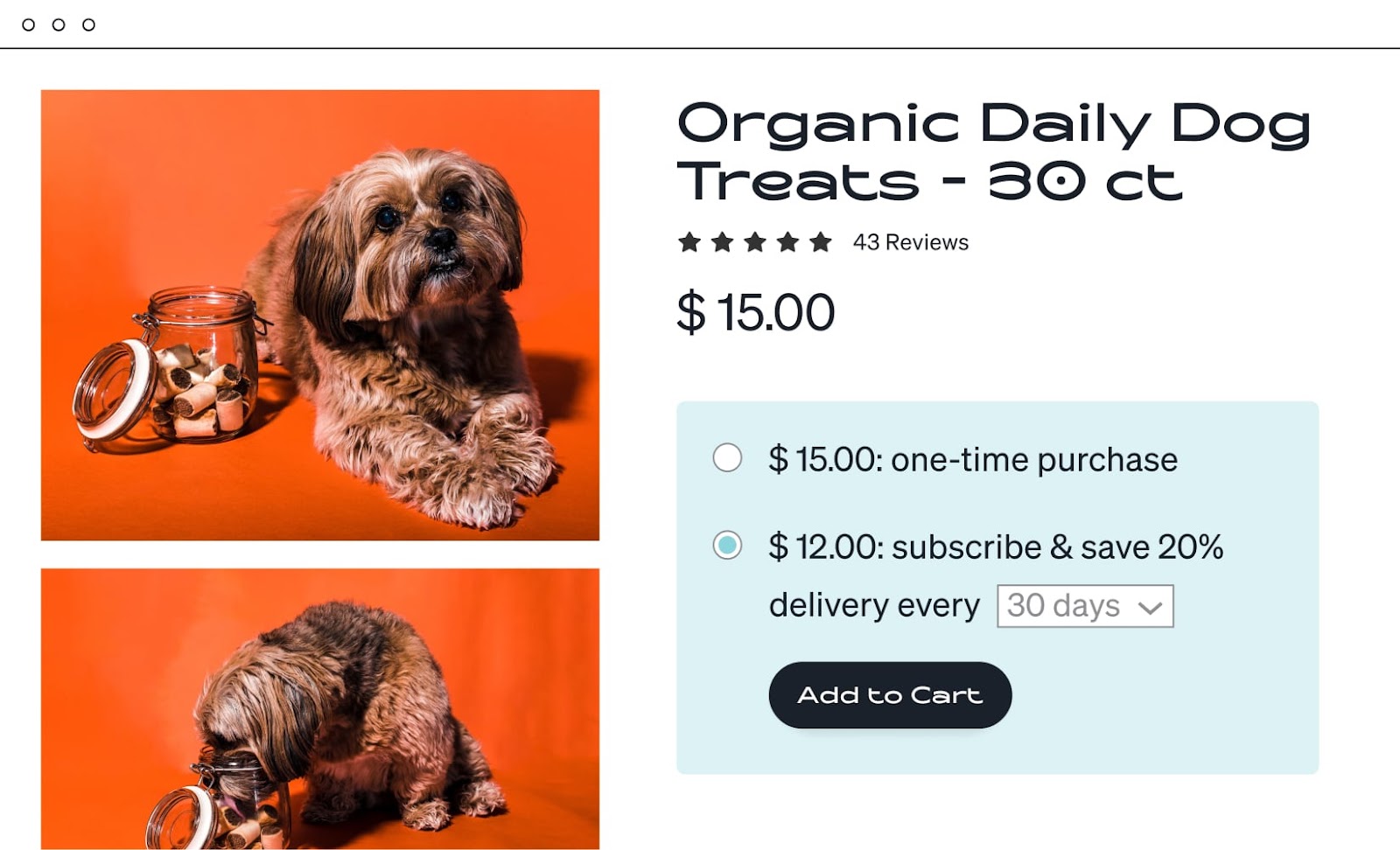
Upselling is when you successfully convince a shopper to upgrade their purchase—for example, getting someone to upgrade to a newer or more advanced (and usually more expensive) model.
It could also be convincing a customer to buy a product bundle or sign up for a subscription instead of a one-off purchase.
Upsells generally deal with the same product or experience.
So, having a shopper switch from buying a table to a couch isn’t an upsell, but convincing a buyer to upgrade their purchase from a table to a table with a set of chairs is.
What is cross-selling?
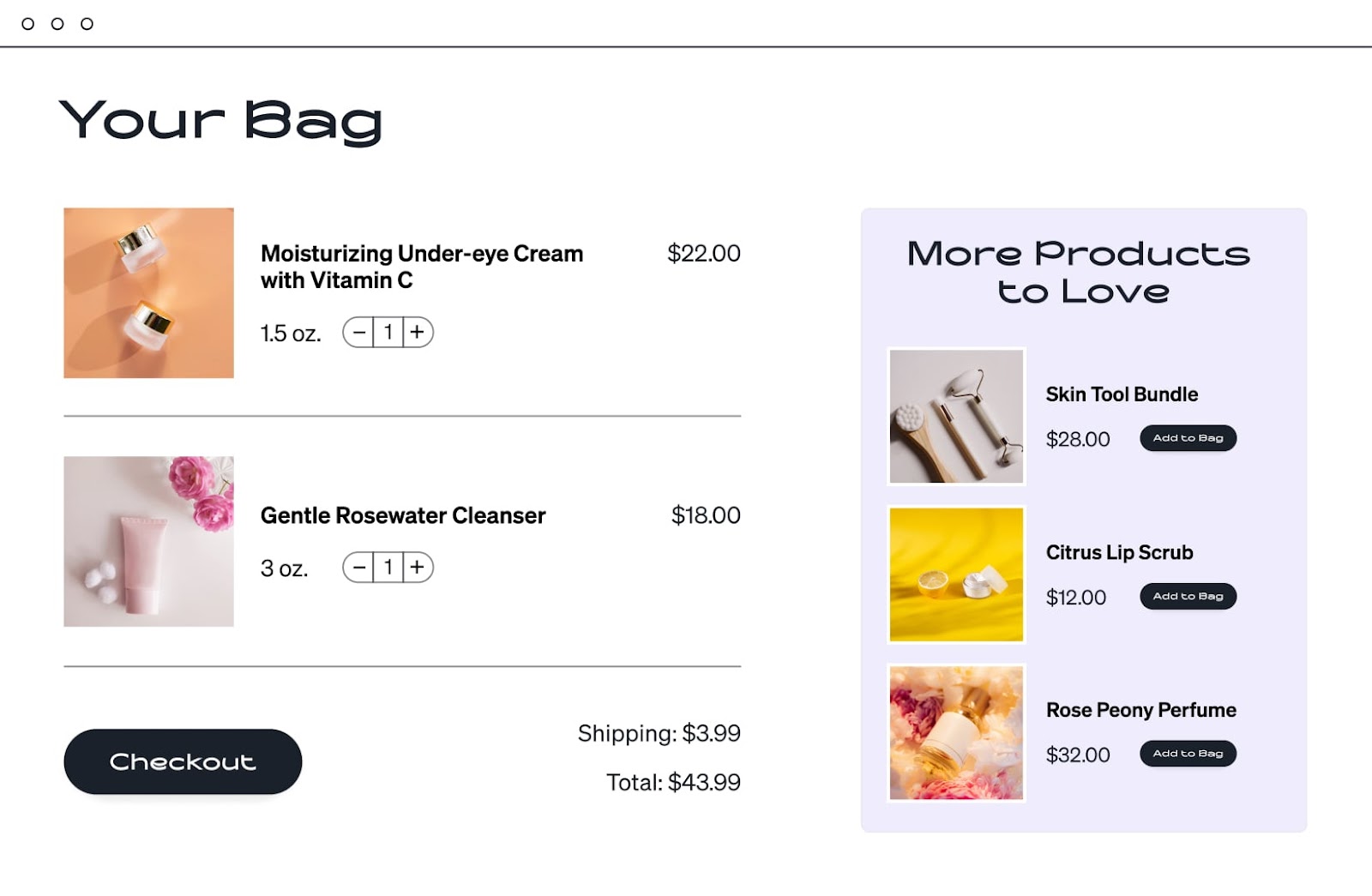
Cross-selling is when you persuade a customer to add complementary items to their cart—for example, convincing someone to buy a facial roller along with their serum purchase or an extra watch band along with their watch.
Cross-selling usually deals with related but different items.
So, getting a buyer to subscribe to a monthly vitamin subscription is not a cross-sell, but successfully encouraging them to add a vitamin carrying case to their order is.
Upselling vs. cross-selling
To summarize, upselling involves one type of product, focusing on getting shoppers to either upgrade or purchase more of the same item (by volume or via subscription).
Meanwhile, cross-selling is about increasing the number of related products in the cart. Instead of a more advanced version of the item, cross-selling suggests related, complementary products.
The benefits of upselling and cross-selling
Upselling and cross-selling come with numerous seller benefits. Let’s cover the top reasons you should incorporate these tactics into your DTC store.
Increase average order values
Upselling or cross-selling across your store can increase how much your shoppers purchase on average, whether by upgrading to a more expensive model or buying additional items.
By successfully matching a shopper with items they didn’t know they wanted, you gain more profit even at the same conversion rate and make your customer acquisition spend go further.
Here’s why these tactics and boosting AOV are an integral part of the selling cycle.
Initially, you need to spend money to attract shoppers to your store—including running ads, participating in webinars, posting on social media, etc.
Every customer you drive to your store costs you and your team time, money, and effort. When you finally get customers over the finish line, though, getting them to purchase isn’t guaranteed.
Your customers need to buy enough to justify the investment you made in drawing them to your store in the first place.
When you boost your average order values, you increase your return on investment for every ad or marketing tactic. McKinsey & Company found cross-selling increases sales by 20% and profits by 30%, and 35% of Amazon’s revenue comes from cross-selling.
For example:
Say you spend $5 for every ad click to your store. Then, 20% of those visitors actually purchase something.
That means if 10 people click on your ad, only two chose to buy something, and you’ve paid $50 for the traffic.
Unless those two customers purchase enough to net you $50 in revenue, you’ve just lost money. So, you have to get that average order value up.
Reduce fulfillment costs
Along with higher average order values come lower fulfillment costs.
The more inventory a customer purchases in the same order, the better you consolidate your items into a single delivery route.
Simply put, the more inventory you can send to customers in fewer deliveries, the more you save on shipping and logistics costs.
As a bonus, this also decreases operational spending, increases customer lifetime value, and boosts your overall profits.
Introduce new items
Even your most loyal fans likely don’t know all the SKUs in your catalog and may miss a new product launch or two.
Despite your best product marketing efforts, not everyone will open your emails, follow your social posts, or peruse your store to discover new gems.
Fortunately, you can use upselling and cross-selling to introduce your shoppers to items they would love but haven’t heard of yet.
That includes, of course, new products that you want to promote and get feedback on.
For example, if you’ve just launched a new model of a popular product, you can upsell from your previous model.
Or, if you have a great accessory that would go well with that best-selling shirt, you can display them paired together to remind shoppers you sell accessories in addition to clothing.
Pro tip: Speaking of product launches, it’s a great idea to create a Coming Soon page for new products so you can start collecting leads early on. Your upsell or cross-sell prompts can lead there to build anticipation and generate some pre-launch sales.
Manage inventory
The probability of selling to an existing customer—for example, someone about to check out—is 60% to 70%, whereas the probability of selling to a new lead is more like 5% to 20%.
Leverage this opportunity to make a sale by strategically directing more spend toward your slow-moving or overstocked items.
It can be challenging to balance your inventory supply and demand.
No one can predict sales volume and velocity with perfect accuracy, so even the most prepared merchants find themselves with too much or too little stock at some point.
Upselling can help you manage inventory when you’re low in stock for a given item.
Instead of depleting your SKU, you can upsell the buyer to a different version of that product and extend your in-stock status for a low-inventory item.
Alternatively, if you have too much inventory for a certain version, you could upsell it.
For example, if your most popular item is a 170 mL bottle of shampoo and you’ve overstocked the 340 mL size, you can push the larger bottle.
Cross-selling can help you sell complementary items you’ve overstocked or that don’t sell as well.
For example, if you have 10 products that complement something your buyer is purchasing and three are overstocked or slow-moving, you can display only those three as suggested products.
Improve buyer experience
Understanding what shoppers might like to purchase with their order and making personalized suggestions improves your buyer experience.
You can remind shoppers of accompanying items they may have forgotten they needed, such as staples for a stapler.
You also delight customers by helping them discover products they didn’t know you sold.
Upselling and cross-selling, when done correctly, will ultimately help both your customers and your business.
#cta-visual-pb#<cta-title>Boost AOV with upsells and cross-sells<cta-title>Build websites that highlight the items your shoppers can’t live without.Start designing for free
Where to implement upselling and cross-selling
Now that we’ve covered why you should upsell and cross-sell, let’s look at where they’re most effective.
When and where to upsell
Whereas cross-selling tends to boost item turnover but not necessarily cart value, upselling reliably increases profit margin.
Unless you’re trying to sell more of a particular SKU to decrease overstock or push a new item, upselling makes the most sense when you’re wanting to increase revenue.
Consider upselling:
- Replenishables, where a subscription would make sense
- Tech that has different versions, such as upgrades and premium models
- Goods that come with add-ons, like a treadmill with optional features
You can upsell on any product or checkout page.
However, a thank-you email or confirmation page may be too late for an upsell due to its single-item focus. Imagine purchasing a new phone, then getting asked, “Do you want the next model?”
When and where to cross-sell
Cross-selling is an excellent way to move inventory and delight your shoppers with new finds.
Turn to cross-selling for products that need other pieces to function, such as a pen and ink refills.
You can also cross-sell items that don’t have an upsell equivalent, such as a pair of jeans or a shirt.
Consider cross-selling:
- Additional parts of an item, like batteries (when they aren’t included)
- Items that will improve the customer experience, like an anti-fog cloth with glasses
- Relevant items for products without a clear upsell, such as shoes or blankets
You can cross-sell throughout your store, including product pages, checkout, confirmation pages, thank you emails, and collection/category pages.
We’ll showcase a few real-life examples of upselling and cross-selling below.
3 great examples of successful upselling
To give you an idea of what great upselling looks like, let’s examine how a few brands do it. We’ll share how brands upsell packages, subscriptions, and a more premium experience.
Dropdown menu of product options
A smart way to introduce upsells to a shopper is to offer them as an option directly within the shopping experience.
For example, you can display your base product with options for different upgrades. Then, before a customer adds the product to their cart, ask them to select their preference.
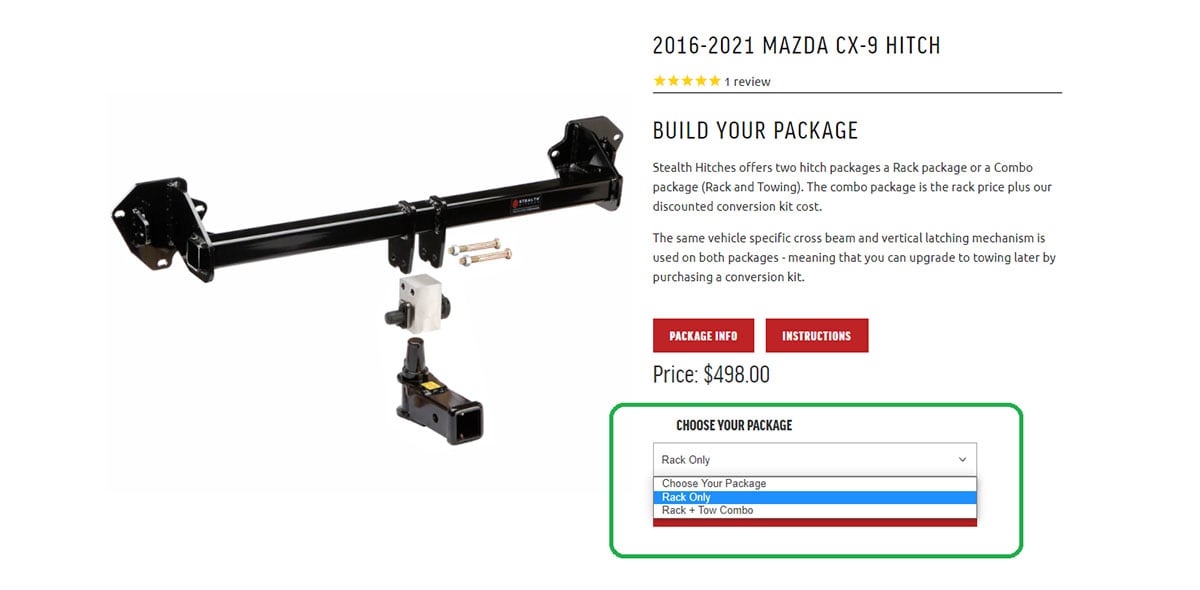
Before a shopper adds a hitch to their cart, Stealth Hitches gives them the option to select their package.
The choices for the product above include just the base product (rack only) or a rack and tow combo.
Further down on their page, they explain what this combo entails.

This is a good summary of the differences in each package, followed up a chart so more visual shoppers can see the benefits of the combo package at a glance.

This section does a great job of highlighting more features for the combo package, boosting the perceived value of the upgrade while answering any questions from shoppers.
Subscribe and save
Subscriptions are an excellent way to upsell someone from a one-time purchase to a recurring one.
They extend your customer lifetime value and makes it seamless for your shoppers to resupply with your brand instead of going to a competitor.
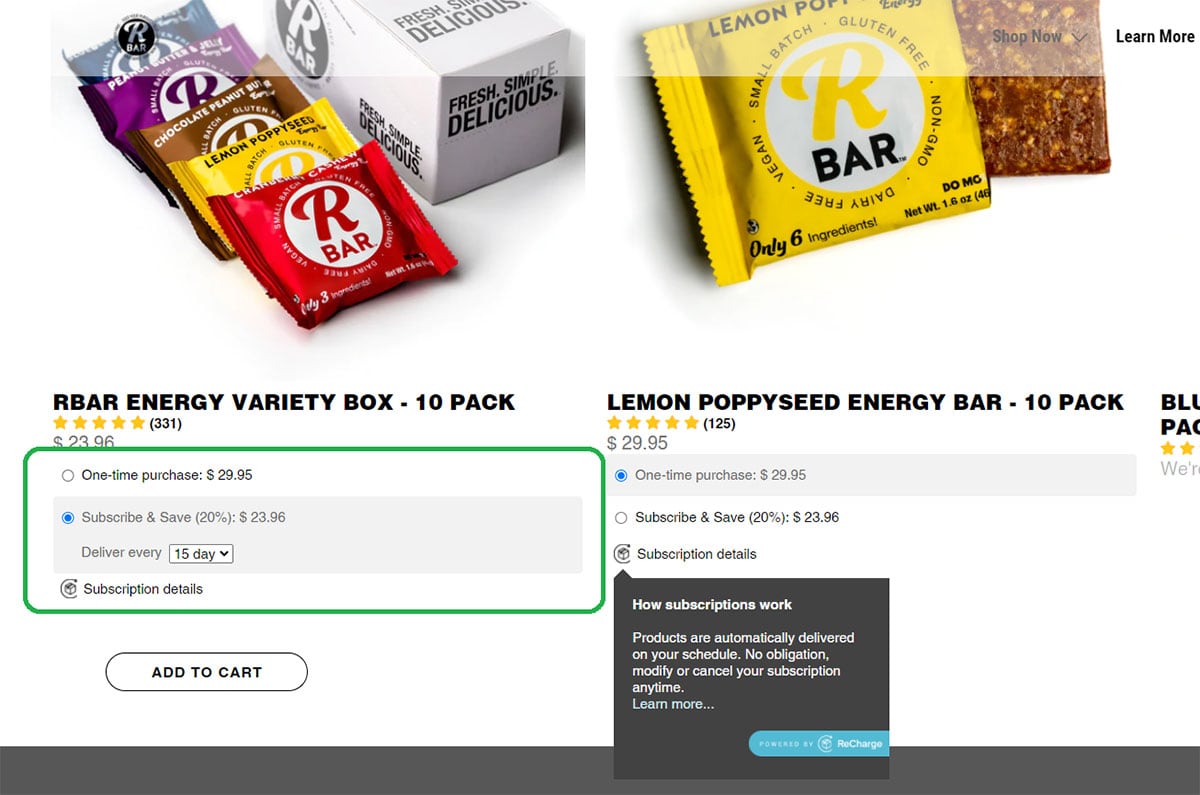
Energy bar brand RBar gives customers an option to “Subscribe & Save” 20% on the retail price for their bars as long as they opt for multiple deliveries.
Their delivery options are every 15, 30, 45, or 60 days.
Allowing shoppers to choose their delivery cadence helps ensure customer satisfaction; they can easily decide what is too often or not often enough.
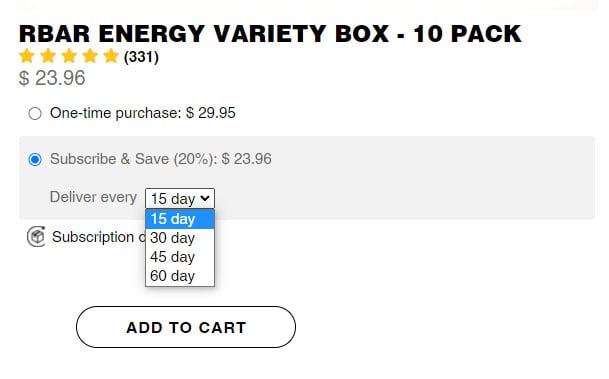
The incentive of getting 20% off is also an excellent tactic for subscriptions. With a small discount, you can:
- Get more overall order volume. You could secure a year-long customer instead of a one-off purchase.
- Save on shipping by planning ahead. You know when to replenish and can use slower standard ground shipping.
- Improve the buyer experience. Your items show up on time and as needed, making you the most convenient choice.
Upgrade your experience
Another way to upsell a customer is by convincing them to upgrade their experience.
This might mean getting the latest laptop or phone model or purchasing a premium version of a product they’re considering.

Dollar Shave Club gives a choice of two razors when you navigate to their razor page, with the more expensive showing first—a valuable pricing strategy.
This helps with price anchoring—those who find $10 too expensive can scroll down and feel like they’ve found a discount. Meanwhile, shoppers comfortable with the $10 price tag will see that first and click through.
The setup of this page earns Dollar Shave Club $2 more for shoppers who are happy to go with the first option they see.
It also helps the brand save a sale for shoppers who find their premium prices too steep.
3 solid examples of successful cross-selling
To give you an idea of what cross-selling looks like, let’s take a peek at some brands that cross-sell by featuring complementary products, related items, and accessories.
Complementary products
To cross-sell products, you can showcase other catalog items that would go well with the base product to cross-sell products.
This is often popular with clothing brands that sell accessories, footwear, handbags, and other products to “complete the look.”
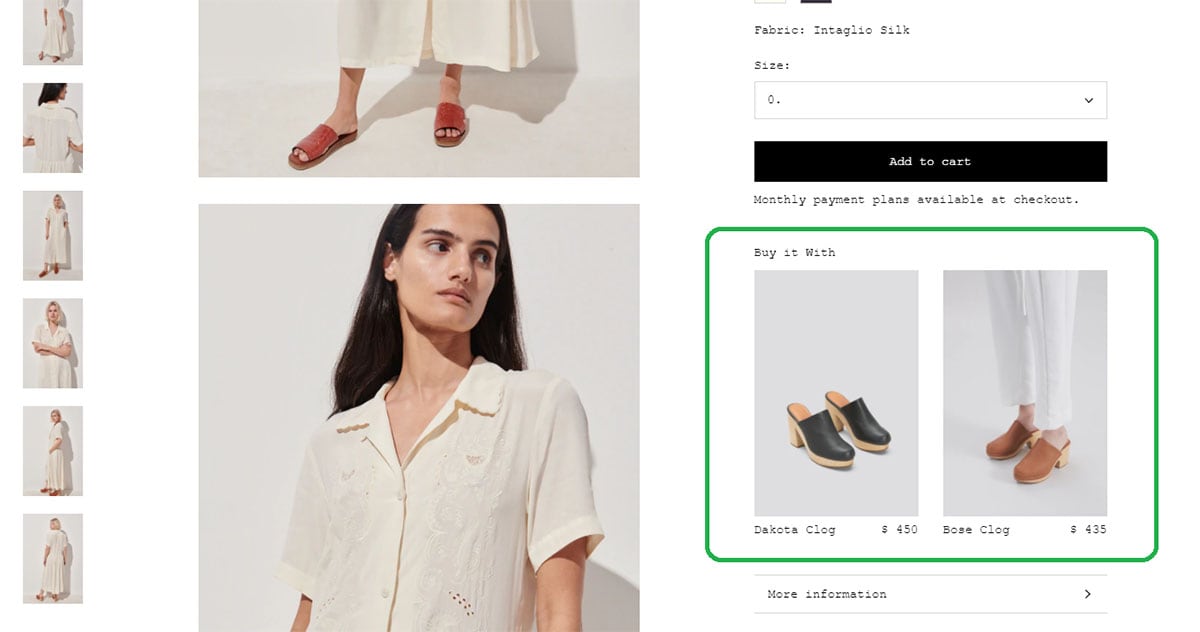
Rachel Comey employs a “Buy it With” section at the bottom of their sidebar, which stays static as shoppers scroll through the photos of the base product.
That gives shoppers more time to view the suggested items while browsing the main product.
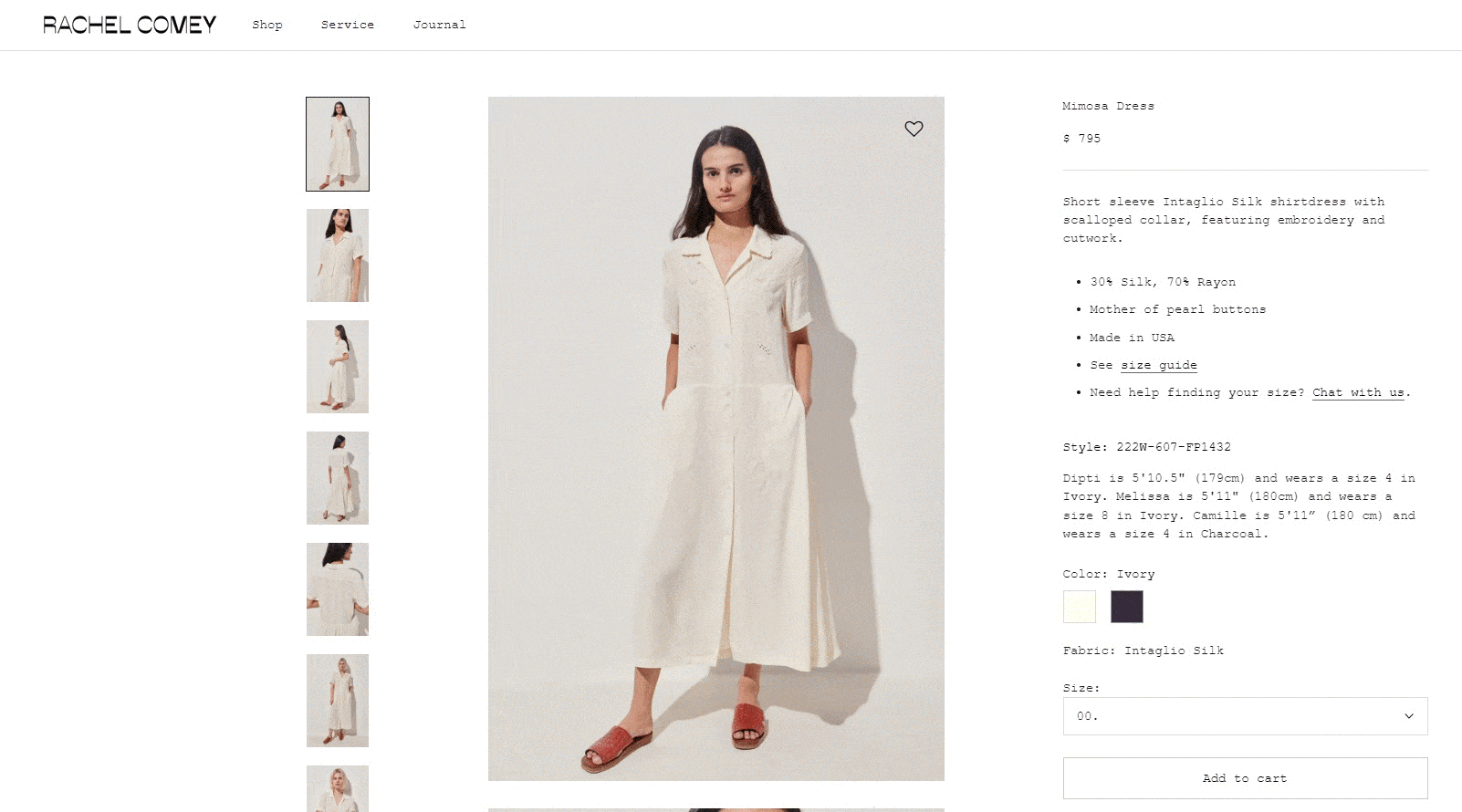
Related items
Cross-selling related products—even if they aren’t always meant to be used directly alongside the main product—can provide a good customer experience.
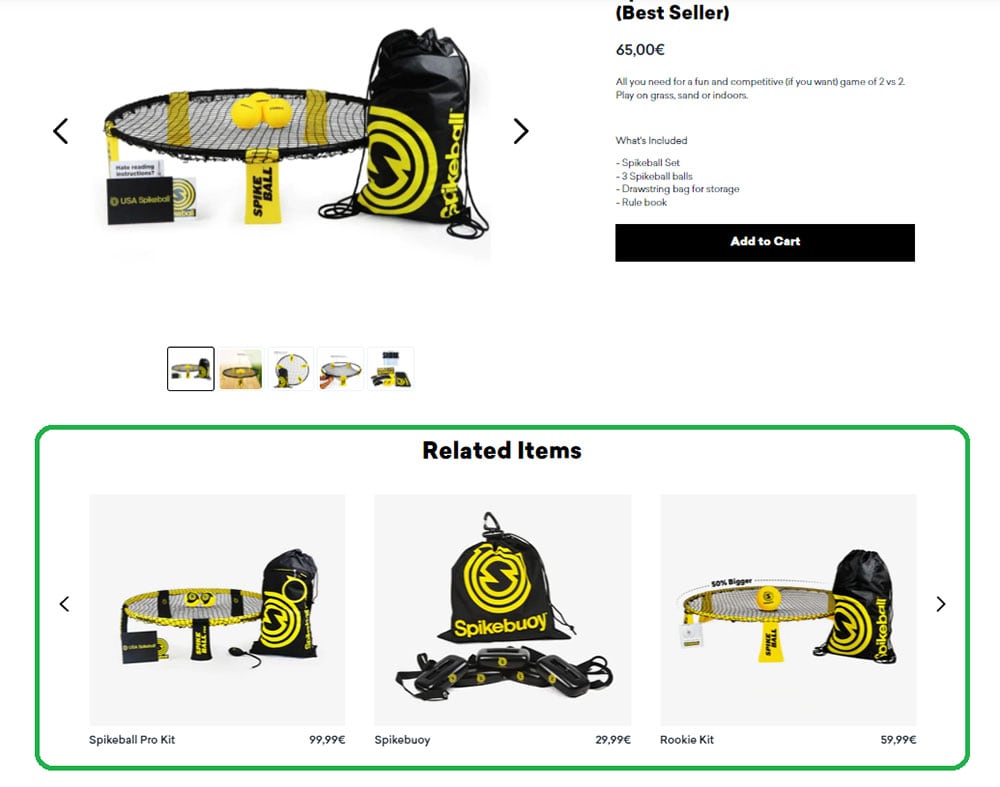
Spikeball shares related items underneath their main product.
In the example above, we were looking at a set. In the related items section, the Spikebuoy isn’t completely necessary for the main product, but it’s still a relevant add-on.
For example, if a buyer decides to play Spikeball in the water, they could add the Spikebuoy to turn it into a water sport.
Add accessories
Showcase accessories and other items that will enrich the customer experience somewhere on the product page.
This reveals possible item combinations with the product and stimulates customers’ imaginations for how else they could use it.
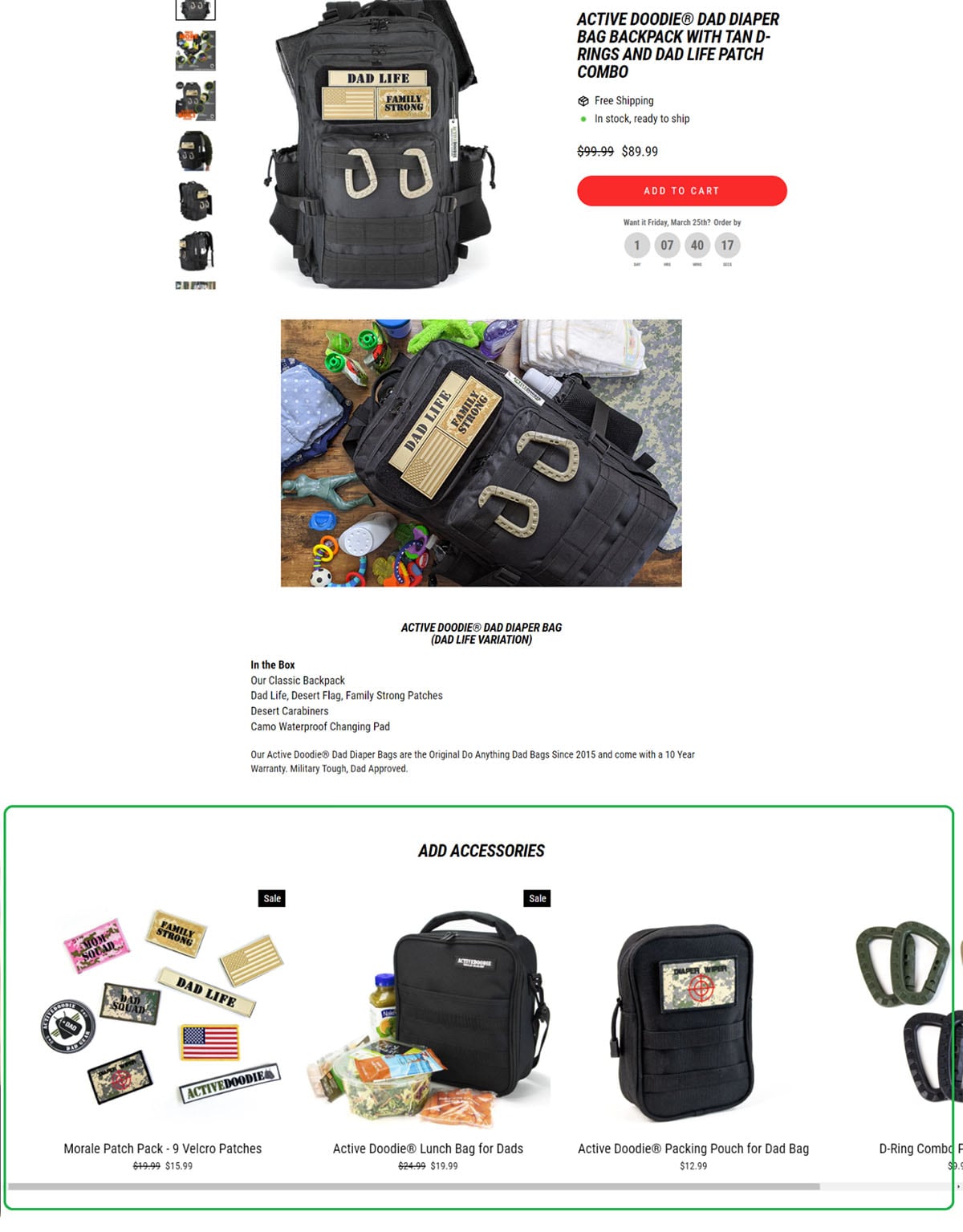
The Active Doodie backpack comes with tons of features for dads on the go. However, there’s so much more the bag can do—with the right accessories.
Their website showcases the main product, lifestyle content to help shoppers imagine themselves using the item, and then accessories to say, “Here’s everything else you might want.”
Upselling and cross-selling best practices
Before you start making changes to your website, it’s vital to lay the right foundation and employ your strategy with intention.
Here are a few best practices to keep in mind.
Avoid choice paralysis
Choice is a good thing, but too much can overwhelm your shoppers.
Instead of drowning them in related products and upgrade options, aim for two to three choices that best complement the main product.
A/B test different options
To determine what options are most likely to convert to an upsell or cross-sell, start A/B testing different choices and track what does well with what products.
A/B tests can reveal which models are too much of a jump, how much more shoppers are typically willing to spend, and how relevant various suggestions are to shoppers.
Limit the price jump
When it comes to upselling, don’t go from the entry-level model straight to the top-tier premium option.
Often, this will be too much of a price jump compared to what shoppers were originally considering.
A helpful tactic is testing your shoppers’ sensitivity to price bumps.
At first, limit your upgrade suggestions to a 30% price increase, then slowly raise it until you notice conversion rates dropping.
Tip: Consider accepting trade-ins to help shoppers who may want the highest upgrade but can’t afford the price difference.
Use price anchoring
Speaking of pricing sensitivity, you can leverage price anchoring to set expectations and boost conversions.
Although there are many ways to do this, one of the most common is to show a “before” price on a discounted upgrade.
For example, you might show that the shopper can upgrade to the next model with a 10% discount.
Although the end cost will be more than their original choice, they’ll note the savings.
Personalize recommendations
Codibook, a Korean fashion site, increased their conversion rate by 59% and average order value 38% by employing personalized recommendations.
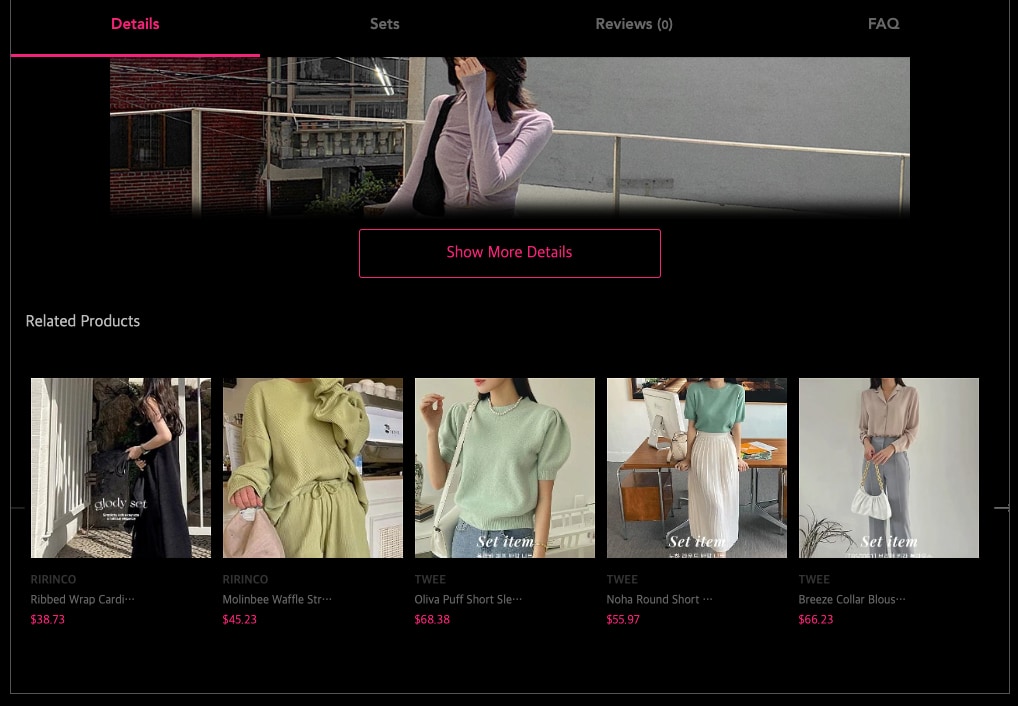
Personalization plays a vital role in making your customers feel understood rather than simply sold to.
When you personalize your upsell and cross-sell recommendations, you show you care about your buyer experience while boosting conversion rates.
According to Instapage, marketers saw a 19% increase in sales after personalizing their web experiences.
Leverage bundles
Product bundles are a strategic way to sell relevant items together while creating a unique SKU that your shoppers can’t find elsewhere.
Bundling is particularly effective for cross-sells because you can highlight price savings and unique deals, which increase the perceived value of the purchase and encourage shoppers to check out.
Place them strategically
Placement matters when it comes to product suggestions.
Avoid interrupting the buying process, which increases customer frustration. Upsells or cross-sells should feel like a welcome, helpful addition to the page, not a sales-like pop-up.
As a general recommendation, display your related items only underneath the key information on the main product page, such as the images, description, and buy button.
For bundles, you can give shoppers a choice when they add to their cart whether they want the base product alone or any of a certain number of deals.
Boost your ROI with cross-selling and upselling
Both upselling and cross-selling are crucial to increasing your average cart values, introducing new SKUs, managing your inventory levels, and improving your buyer experience.
Take inspiration from the examples provided here to build your own upsell and cross-sell strategies on your website.
When executed well, your average order values, customer lifetime value, and return on acquisition spend will thank you.
#cta-visual-pb#<cta-title>Increase customer satisfaction, sales, and profits with upsells and cross-sells<cta-title>Create a seamless buyer experience with Shogun Page Builder and personalized suggestions.Start building for free

Rachel Go
Rachel is a remote marketing manager with a background in building scalable content engines. She creates content that wins customers for B2B ecommerce companies like MyFBAPrep, Shogun, and more. In the past, she has scaled organic acquisition efforts for companies like Deliverr and Skubana.



